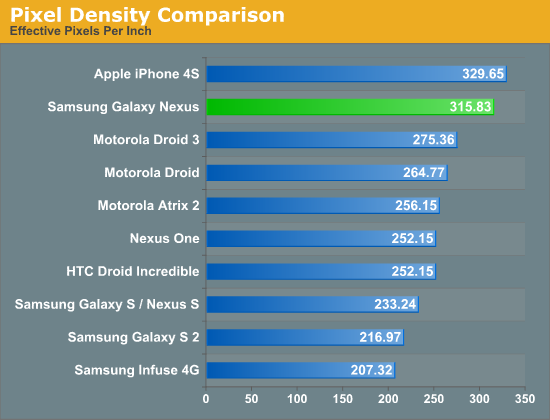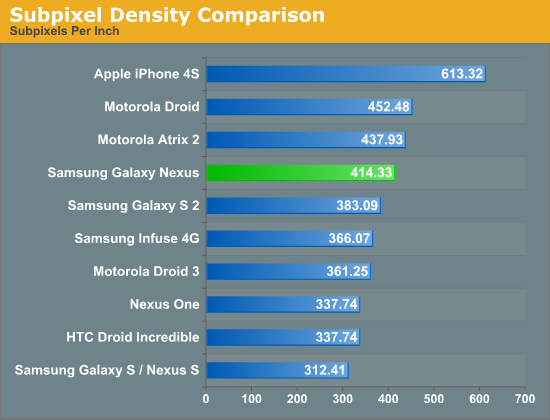Confirmed: Galaxy Nexus Includes PenTile
by Brian Klug & Jason Inofuentes on October 21, 2011 12:58 AM EST- Posted in
- Smartphones
- Samsung
- Ice Cream Sandwich
- Mobile
- AMOLED
- galaxy nexus
Though we've learned a lot about the Galaxy Nexus specifications already, one of the things that has remained a question thus far is whether its 4.65" 720p HD Super AMOLED display uses an RGB subpixel rendering layout or PenTile. We've now confirmed that the Galaxy Nexus display does in fact use RGBG PenTile, like all the Nexus devices to date. This isn't super surprising considering that Samsung has been pretty good about adhering to all the monikers it has gradually been tacking onto AMOLED. There are a number so far - 'super' connotes an optically bonded panel and digitizer stack, 'plus' connotes an RGB stripe, and now 'HD' connotes, well, 720p. HD Super AMOLED lacks Plus, and thus isn't an RGB stripe.
The next question is just what 4.65" HD Super AMOLED will look like, or whether the presence of PenTile will be as noticeable as previous AMOLED phones like the Nexus S / Galaxy S or Nexus One where it was arguably very noticeable. That said, at some subpixel density it should become difficult to impossible to notice PenTile's presence, it's just a matter of exceeding human visual acuity. Having not seen the Galaxy Nexus in person yet and given the absence of good macro shots of the display, we have put together a numerical comparison pitting the Galaxy Nexus panel up against some other common smartphone displays.
First up is a quick plot of the effective pixel density of some popular displays. Stated another way, this is the pixel density based on the manufacturer's stated logical resolution, which is also the resolution of Android's render target for the phone.

Note that this is the traditional means of reporting pixels per inch that we've published before. However, using this metric is just a bit misleading since it doesn't take into account the difference between 2 subpixel-per-pixel RGBG or RBGW PenTile versus the 3 subpixel-per-pixel RGB stripe. To make for an effective comparison, we've put together another plot where we take into account the presence of PenTile and report subpixel density.

Here things still look pretty good for the 4.65" HD Super AMOLED display, putting it just north of SGS2's Super AMOLED Plus display with an RGB stripe. I wager that if you were satisfied with the pixel density of SGS2 that the pixel density Galaxy Nexus actually won't be off-putting despite the presence of PenTile. In addition, hopefully some of the UI design considerations that come along with using PenTile (no vertical 1 pixel thick elements) have been taken into consideration from the outset for Ice Cream Sandwich. For true subjective impressions however, we'll have to wait and see.
Source: Data










152 Comments
View All Comments
thegadgetlife.com.au - Friday, October 21, 2011 - link
We confirmed this a while ago at http://www.thegadgetlife.com.au, when the Galasy S II HD and Galaxy Note were first announced with similar pentile screens.While it is true that it should at least be comparable to the Galaxy S II screen, the compromise doesn't make sense except for marketing - why modify the perfectly good SGS II screen simply to be able to pass it off as an 'HD' screen?
I don't quite understand how you calculated the subpixel per inch figures above but they appear to be wrong - check http://thegadgetlife.wordpress.com/2011/09/03/the-... for an explanation. The calculation sohuld be simple, the iPhone 4S and Samsung Galaxy S II have 3 subpixels per inch, so multiply by three for them, and by 2 for pentile screens.
So the subpixel density is:
iPhone 4S: 990
Galaxy Nexus: 632
Galaxy S II: 651
Galaxy S/ Nexus S AMOLED: 466
Droid Razr: 512
I don't know how you made your calculations but they appear to be wrong. The Galaxy S II actually has a slightly higher sub pixel density.
You also don't mention that the Droid Razr also uses a pentile RGBG screen (again check http://www.thegadgetlife.com.au for proof and details). The subpixel density for the Droid Razr is 256x2 i.e. a mere 512ppi.
Brian Klug - Friday, October 21, 2011 - link
This is not the correct way to calculate subpixel density, as you cannot simply scale the effective pixel density by 2 or 3 in that manner. Recall that subpixel rendering layouts affect the density in horizontal space, not vertical space, eg there are three horizontal subpixels per logical pixel in RGB, two subpixels per logical pixel in RGBG or RBGW PenTile. Thus, the computation is a bit more involved than merely scaling.The computation in this case involves calculating the horizontal subpixel density and vertical density (which is the same as vertical resolution in this case), then calculating.
To imply that there are 990 subpixels per inch in the iPhone 4/4S should immediately raise an eyebrow, as this implies that logical pixels are comprised of 3x3 subpixels, which is obviously not the case.
So in reality, my computation is not incorrect, but you may want to revise your own blog post :P
Also I've seen the photo in mention on droid-life and while it is immediately obvious their subpixel rendering layout is not RGB, it isn't clear to me what it actually is.
-Brian
doobydoo - Saturday, March 17, 2012 - link
Brian, are you sure?Consider a screen which has 9 ppi:
(here is one inch)
xxx
xxx
xxx
(3)
Each of those pixels is made up of 3 pixels:
(same one inch in sub pixels)
xxx xxx xxx
xxx xxx xxx
xxx xxx xxx
(27)
Thus, you can simply multiply by 3.
It's obvious really, PPI is a measure of pixels. 1 pixel = 3 subpixels. So to go from pixels per inch to sub pixels per inch, you multiply by 3. Thus the iPhone 4S has 990.
doobydoo - Saturday, March 17, 2012 - link
The (3) should read (9)PWRuser - Friday, October 21, 2011 - link
"While it is true that it should at least be comparable to the Galaxy S II screen, the compromise doesn't make sense except for marketing - why modify the perfectly good SGS II screen simply to be able to pass it off as an 'HD' screen?"Hmm, I wonder why. Maybe because the HD resolution is a natural progression after ~3 years of WVGA? Or maybe because LG, Hitachi and others are about to introduce their HD displays? Or maybe because a ~200 pixel density doesn't cut it in 2012?
lammers42 - Friday, October 21, 2011 - link
The super amoled plus screens were consuming much more power than the older super amoled. I thought that the HD super amoled was supposed to correct the increased power consumption and keep the RGB subpixel layout, but I guess we wait until next year for that.thegadgetlife.com.au - Friday, October 21, 2011 - link
Still trying to make sense of how you calculate suboixel densities. As I understand simply multiplying the ppi by 2 or 3 for pentile and RGB stripe displays respectively should give you the subpixel density.Brian Klug - Friday, October 21, 2011 - link
I explained this above in my original reply, but the trick is that there is only one vertical pixel per subpixel. This absolutely must be taken into account.Stated another way, if we're counting subpixels, one must take into account that RGB and RGBG/RGBW merely affect the horizontal subpixel rendering layout,
eg: two "pixels" in both lands: RGB, RGB = ||| ||| and RG, BG = || ||
There isn't a change in the vertical direction, thus you cannot simply scale the pixel density by some scalar. Instead, you must recompute the actual horizontal resolution (which is 2*horizontal resolution for RGBG or RGBW, and 3*horizontal resolution for RGB) and vertical resolution (which is unchanged), and then pipe those actual subpixel resolutions into your pixel density calculation, which is:
sqrt((horizontal)^2+(vertical)^2)/(size in inches)
Then you will arrive at the actual subpixel density in subpixels/inch.
-Brian
doobydoo - Saturday, March 17, 2012 - link
Brian, you don't need to use any square root in your formula.The number of sub-pixels in an inch is simply:
(horizontal sub pixels * vertical sub pixels ) / size in inches
ie, the number of sub pixels / inch
For some reason, you are calculating the diagonal length, in sub pixels.
Look at the examples you gave of pixels (lets assume this is a 2 ppi display with a resolution of 2x1 and a screen size of 1 inch squared)
RGB: ||| ||| - 2 pixels, 6 sub pixels (2 x 3)
RG BG: || || - 2 pixels, 4 sub pixels (2 x 2)
Plug your own formula into this, and you get:
RGB: sqrt (( 6^2 + 1^2))/ 1
or:
RG BG: sqrt (( 4^2 + 1^2)) / 1
This gives sqrt (37) for RGB which is 6.08. But there are 6. For the RG BG it gives sqrt (17) which is 4.12. But there are 4. So your formula is wrong. Note that what you've actually calculated is some bizarre form of Pythagoras which measures the length of the diagonal of the screen, in sub pixels. And then divides by the area of that screen, in inches. It's a meaningless number.
sjael - Friday, October 21, 2011 - link
Have to agree - I can't figure out how they got the second graph at all.In addition, it's not fair at all to compare RGBG PenTile to RGB Stripe solely on the number of sub-pixels employed. RGBG PenTile still has the same number of green sub-pixels, which are the most important to image detail. And it's not just that - PenTile doesn't even really draw to physical pixel coordinates like a standard display does.
Even so, at its absolute worst (solid blue text on a solid red background?) the PenTile screen shouldn't really look any worse than a qHD display at the same size. At its best it will look far better.